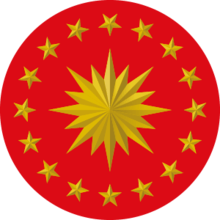16 Great Turkic Empires
The 16 Great Turkic Empires (Turkish: 16 Büyük Türk Devleti, also translated as "16 Great Turkish Empires") is a concept in Turkish ethnic nationalism, introduced in 1969 by Akib Özbek[2] and widely invoked by Turkish authorities during the 1980s, under the government of Kenan Evren.

The list
The "16 Great Turkic Empires" are the following:
| Flag (fictional)[3] |
Name | Turkish name | Leader[4] | Dates[5] |
|---|---|---|---|---|
| Great Hunnic Empire | Büyük Hun İmparatorluğu | Mete Han | 220 BC-46 BC | |
| Western Hunnic Empire | Batı Hun İmparatorluğu | Panu | 48-216 | |
| European Hunnic Empire | Avrupa Hun İmparatorluğu | Attila | 375-469 | |
| White Hunnic Empire | Akhun İmparatorluğu | Aksunvar | 390-577 | |
| Göktürk Empire | Göktürk İmparatorluğu | Bumin Qaghan | 552-745 | |
| Avar Khaganate | Avar İmparatorluğu | Bayan Kağan | 565-835 | |
| Khazar Khaganate | Hazar İmparatorluğu | Ziebel | 651-983 | |
| Uyghur Khaganate | Uygur Devleti | Kutluğ Kül Bilge Kağan | 745-1369 | |
| Kara-Khanids | Karahanlılar | Bilge Kul Qadir Khan | 840-1212 | |
| Ghaznavids | Gazneliler | Alp Tekin | 962-1186 | |
| Great Seljuq Empire | Büyük Selçuklu İmparatorluğu | Selçuk Bey | 1040–1157 | |
| Khwarazmids | Harzemşahlar | Muhammed Harzem Şah | 1097–1231 | |
| Golden Horde | Altınordu Devleti | Batu Han | 1236–1502 | |
| Timurid Empire | Büyük Timur İmparatorluğu | Timur | 1368–1501 | |
| Mughal Empire | Babür İmparatorluğu | Babür Şah | 1526-1858 | |
| Ottoman Empire | Osmanlı İmparatorluğu | Osman Bey | 1299-1922 |
Reception

Turkish nationalist writer, novelist, poet and philosopher, Hüseyin Nihâl Atsız, supporter of the pan-Turkist or Turanism ideology, had noted that while some states with questionable Turkic identity were included in the list, some ostensibly Turkic states (such as Akkoyunlu) were left out, and labeled the list a "fabrication."[6]
In spite of Atsız' criticism, the concept was made a mainstream topos in Turkish national symbolism in the wake of the 1980 Turkish coup d'état, under the presidency of Kenan Evren, when "Turkish-Islamic synthesis" was declared the official nature of Turkish national identity. The Turkish Postal administration issued a series of stamps dedicated to the 16 Empires in 1984, showing portraits of their respective founders as well as attributed flags.[3] In 1985, Özbek's 16 Empires were invoked as a retrospective explanation of the 16 stars in the presidential seal of Turkey (introduced in 1936).[7]
Several municipal buildings and public parks in Turkey have collections of busts or statues of the supposed founders of the "16 Empires" alongside a statue of Kemal Atatürk, including the municipal buildings of Keçiören (Ankara), Mamak, Ankara, Etimesgut, Niğde, Nevşehir, Pınarbaşı, Kayseri, etc.[4]
In 2000, Türk Telekom produced a series of smart cards dedicated to the topic.[8]
In January 2015, Turkish president Recep Tayyip Erdoğan received Palestinian president Mahmoud Abbas in the Turkish Presidential Palace with a guard of 16 "warriors", actors wearing loosely historical armour and costume, intended to symbolise the 16 empires.[9] The costumes were ridiculed in the Turkish media, and one of the costumes in particular was mocked as a "bathrobe", becoming a trend on social media under the name of Duşakabinoğulları (as it were "son of the shower cabin").[10]
| Wikimedia Commons has media related to Flags of the 16 Great Turkic Empires. |
See also
References
- France-Presse, Agence (2015-01-12). "Abbas welcomed at Turkish presidential palace by Erdoğan – and 16 warriors". The Guardian. ISSN 0261-3077. Retrieved 2019-12-12.
- H. Feridun Demokan, Contemporary Turkey: Geography, History, Economy, Art, Tourism, Demokan, 1978, p. 4. Necdet Evliyagil, Sami Güner, Basın-Yayın Genel Müdürlüğü, Ajans-Türk, Türkiye: Cumhuriyetin 50. Yıl Kitabı, Ajans-Türk Matbaacılık Sanayii, 1973.
- Ivan Sache, Presentation of the Sixteen Great Turkish Empires and their alleged flags, Flags of the World, 4 July 2004; c.f. jpeg of the 1984 stamp series. The flags were designed by Özbek in 1969. They are mostly imaginary, with the exception of the 1844 Ottoman flag, and arguably the wolf's head and the bow-and-arrow used as emblems for the Göktürk and the Seljuk states, respectively. Ekrem Buğra Ekinci, 16 TÜRK DEVLETİ Cumhurbaşkanlığı forsundaki 16 yıldız neyi ifade ediyor?, 2 February 2015.
- Keçiören 39°58′41″N 32°52′3″E. Etimesgut Belediyesi kent meydanı için hazırlanan 16 Türk Büyüğü heykelleri. Niğde’nin simgesi Türk Büyükleri heykelleri kaldırılıyor mu? Türk devlet büyükleri Mamak'ta Türk Büyükleri Anıtları Yenilendi (Nevşehir). "Pınarbaşı Turkishness Monument" (Pınarbaşı Türklük Anıtı, opened in 2000).
- Dates as shown in the original document
- On line history newspaper ((in Turkish)) Archived 2016-03-21 at the Wayback Machine Nihal Atsız (in Turkish)
- Central Eurasian Studies Review, Vol. 3, Central Eurasian Studies Society, 2004, p. 23
- Büyük Türk Devletleri
- "Spear-carriers and chainmail warriors: Erdogan's palace welcome". Yahoo! News. Retrieved 14 January 2015.
- "'Duşakabinoğulları' istifa getirdi: O kıyafete 'bornoz' diyen dekan görevinden ayrıldı" (in Turkish). Diken. Retrieved 29 May 2016. "Duşakabinoğulları 3 ay sürmüş!" (in Turkish). Sözcü. Retrieved 29 May 2016. "Duşakabinoğullarını Dolmabahçe Sarayı'na getirdi" (in Turkish). Birgün. Archived from the original on 2016-05-27. Retrieved 29 May 2016. The Takvim daily newspaper omitted a label for this particular costume (Western Hunnic Empire) by mistake; diken.com.tr.